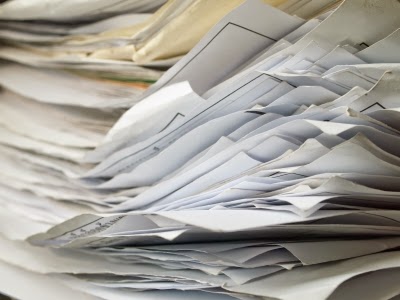 |
| Image courtesy of nuttakit at FreeDigitalPhotos.net |
While many of us are actively turning to online billing and payment, and prefer to read our news online, the flyers at our door never cease. The forms sent home from school are unending, our receipts are piling and the general paper trail of life continues.
I desperately needed a system for organizing the stacks of paper piled precariously on my filing cabinet. The five principles outlined below helped me get started and can assist you too!
- Each piece of paper needs a home: For me, this principle is ground zero for organizing. Without designating a home for each type of paper (e.g., newspapers, bills, correspondences, coupons, and records), paper just gets shifted around. Different types of paper should have different homes depending on how easily and frequently you need to access that paper. I use baskets, filing cabinets, decorative paper sorters and shoe boxes to file and store my paper.
- Take three minutes a day: My paper clutter accumulated after not taking the time each day to sort. Once a home has been designated for each type of paper, it should take three minutes (or less) daily to organize. You may also choose to do this task weekly, but if you extend it longer than that, those dastardly piles start forming again.
- Sort at the source: I’ve developed three filing systems all located near my front door so that when paper enters the house is gets sorted before it can clutter my home. You may choose to organize paper based on whether it requires action, recycling or filing. In my home, there is a cabinet for newspapers and magazines, a basket for flyers and non-urgent papers, and a decorative filing box for important mail requiring action (e.g., school papers, bills, health claims). Once that urgent mail has been addressed, it is stored away in a filing cabinet.
- Shred and recycle: If paper makes it into your house every day, ensure that paper also leaves it daily. Recycle flyers and newspapers regularly and shred personal mail frequently. We invested in an extra recycling bin since we found that our bin was overflowing each week. If you live in Toronto, it’s quick, easy and inexpensive to order your extra recycling bin online.
- Scan and save: This is the last step which I’m still working towards. With cheap scanning technology available on every multi-function printer, there is no reason why you can’t scan paper and store everything on your computer (and your back-up hard drive, of course). You can even outsource the scanning of your photos to a third-party, such as The Shoebox Services offered by Black’s Photo. Rationally, it makes sense to digitize paper that gets stored away but, emotionally, there is still nothing like sorting through a box of photo memories.
And that paperless office concept, it’s largely a myth. According to a 2013 United States Environmental Protection Agency study, the average office worker generates approximately two pounds of paper and paperboard products each day.[4]
Happy shredding!

No comments:
Post a Comment